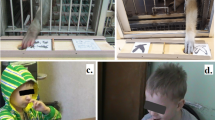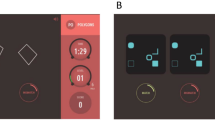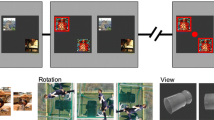Abstract
Four orangutans and one gorilla matched images in a delayed matching-to-sample (DMTS) task based on the relationship between items depicted in those images, thus demonstrating understanding of both first- and second-order relations. Subjects matched items on the basis of identity, color, or shape (first-order relations, experiment 1) or same shape, same color between items (second-order relations, experiment 2). Four of the five subjects performed above chance on the second-order relations DMTS task within the first block of five sessions. High levels of performance on this task did not result from reliance on perceptual feature matching and thus indicate the capability for abstract relational concepts in two species of great ape.


Similar content being viewed by others
References
Bhatt RS, Wright AA (1992) Concept learning by monkeys with video picture images and a touch screen. J Exp Anal Behav 57:219–225
Bovet D, Vauclair J (2001) Judgement of conceptual identity in monkeys. Psychon Bull Rev 8:470–475
Burdyn LE Jr, Thomas RK (1984) Conditional discrimination with conceptual simultaneous and successive cues in the squirrel monkey (Saimiri sciureus). J Comp Psychol 4:405–413
Cook BR, Cavoto KK, Cavoto BR (1995) Same-different texture discrimination and concept learning by pigeons. J Exp Psychol Anim Behav Process 21:253–260
Cook RG, Katz JS, Cavoto BR (1997) Pigeon same-different concept learning with multiple stimulus classes. J Exp Psychol Anim Behav Process 23:417–433
D'Amato MR, Salmon DP, Colombo M (1985) Extent and limits of the matching concept in monkeys (Cebus apella). J Exp Psychol Anim Behav Process 11:35–51
D'Amato MR, Salmon DP, Loukas E, Tomie A (1986) Processing of identity and conditional relations in monkeys (Cebus apella) and pigeons (Columba livia). Anim Learn Behav 14:365–373
Fagot J, Wasserman EA, Young ME (2001) Discriminating the relation between relations: the role of entropy in abstract conceptualization by baboons (Papio papio) and humans (Homo sapiens). J Exp Psychol Anim Behav Process 27:316–328
Fujita K (1983) Formation of the sameness-difference concept by Japanese monkeys from a small number of color stimuli. J Exp Anal Behav 40:289–300
Garcha HS, Ettlinger G (1979) Object sorting by chimpanzees and monkeys. Cortex 15:213–224
Gillan DJ, Premack D, Woodruff G (1981) Reasoning in the chimpanzee 1. Analogical reasoning. J Exp Psychol Anim Behav Process 7:1–17
Giurfa M, Zhang S, Jenett A, Menzel R, Srinivasan MV (2001) The concepts of 'sameness' and 'difference' in an insect. Nature 410:930–933
McClure MK, Culbertson G (1977) Chimpanzees' spontaneous temporal sorting of stimuli on the basis of physical identity. Primates 18:709–711
Oden DL, Thompson RKR, Premack D (1988) Spontaneous transfer of matching by infant chimpanzees. J Exp Psychol Anim Behav Process 14:140–145
Oden DL, Thompson RKR, Premack D (1990) Infant chimpanzees spontaneously perceive both concrete and abstract same/different relations. Child Dev 61:621–631
Pepperberg I (1987) Acquisition of the same/different concept by and African grey parrot (Psittacus erithacus): learning with respect to categories of color, shape, and material. Anim Learn Behav 15:423–432
Premack D (1983) The codes of man and beasts. Behav Brain Sci 6:125–167
Premack D, Premack AJ (1983) The minds of an ape. Norton, New York
Roitblat HL, Von Fersen L (1992) Comparative cognition: representations and processes in learning and memory. Annu Rev Psychol 43:671–710
Spinozzi G (1993) Development of spontaneous classificatory behavior in chimpanzees (Pan troglodytes). J Comp Psychol 107:193–200
Spinozzi G, Natale F (1989) Classification. In: Antinucci F (ed) Cognitive structure and development in nonhuman primates. Erlbaum, Hillsdale, N.J., pp 163–187
Spinozzi G, Natale F, Langer J, Brakke KE (1999) Spontaneous class grouping behavior by bonobos (Pan paniscus) and common chimpanzees (P. troglodytes). Anim Cogn 2:157–170
Tanaka M (1995) Object sorting in chimpanzees (Pan troglodytes): classification based on physical identity, complementarity, and familiarity. J Comp Psychol 109:151–161
Tanaka M (1996) Information integration about object-object relationships by chimpanzees (Pan troglodytes). J Comp Psychol 110:323–335
Thomas RK, Kerr S (1976) Conceptual conditional discrimination in Saimiri sciureus. Anim Learn Behav 4:333–336
Thompson RKR, Oden DL (1996) A profound disparity revisited: perception and judgement of abstract identity relations by chimpanzees, human infants and monkeys. Behav Process 35:149–161
Thompson RKR, Oden DL (2000) Categorical perception and conceptual judgements by nonhuman primates: the paleological monkey and the analogical ape. Cogn Sci 24:363–396
Thompson RKR, Oden DL, Boysen ST (1997) Language-naïve chimpanzees (Pan troglodytes) judge relations between relations in a conceptual matching-to-sample task. J Exp Psychol Anim Behav Process 23:31–43
Tomasello M, Call J (1997) Primate cognition. Oxford University Press, Oxford
Vonk J, MacDonald SE (2002) Natural concept formation in a juvenile gorilla (Gorilla gorilla gorilla) at 3 levels of abstraction. J Exp Anal Behav 78:315–332
Wasserman EA, Hugart JA, Kirkpatrick-Steger K (1995) Pigeons show same-different conceptualization after training with complex visual stimuli. J Exp Psychol Anim Behav Process 21:248–252
Wasserman EA, Young ME, Nolan BC (2000) Display variability and spatial organization as contributors to the pigeon's discrimination of complex visual stimuli. J Exp Psychol Anim Behav Process 26:133–143
Wasserman EA, Fagot J, Young ME (2001a) Same-different conceptualization by baboons (Papio papio): the role of entropy. J Comp Psychol 115:42–52
Wasserman EA, Young ME, Fagot J (2001b) Effects of number of items on the baboon's discrimination of same from different visual displays. Anim Cogn 4:163–170
Young ME, Wasserman EA (1997) Entropy detection by pigeons: response to mixed visual displays after same-different discrimination training. J Exp Psychol Anim Behav Process 23:157–170
Young ME, Wasserman EA, Dalrymple R (1997a) Memory-based same-different conceptualization by pigeons. Psychon Bull Rev 4:552–558
Young ME, Wasserman EA, Garner KL (1997b) Effects of number of items on the pigeon's discrimination of same from different visual displays. J Exp Psychol Anim Behav Process 23:491–501
Young ME, Wasserman EA, Hilfers MA, Dalrymple R (1999) The pigeon's variability discrimination with lists of successively presented visual stimuli. J Exp Psychol Anim Behav Process 25:475–490
Acknowledgements
This research was supported by a Natural Sciences and Engineering Research Council (NSERC) postgraduate scholarship granted to the author. The cooperation and support of the staff at the Toronto Zoo was greatly appreciated. Special thanks to Dianne Devison, Bev Carter, Vanessa Phelan, Gerri Mintha, Charles Guthrie, Tim McCaskie, Connie Wiederman, Heidi Minicke, Michelle Smith, Karyn Tunwell, Bridget Burke-Johnson, Andrea Beatson, Rick Vos, David Partington, Des Macguire, John Armstrong, and Jackie Craig, without whose assistance this study would not have been possible. I am also grateful to Suzanne MacDonald for the opportunity to undertake this project, and for providing the equipment and her guidance. Thanks to Robert Sorge, Roger Thompson, and several anonymous reviewers for comments on earlier drafts. These experiments conform to the Canadian laws and regulations concerning the use of animals.
Author information
Authors and Affiliations
Corresponding author
Rights and permissions
About this article
Cite this article
Vonk, J. Gorilla (Gorilla gorilla gorilla) and orangutan (Pongo abelii) understanding of first- and second-order relations. Anim Cogn 6, 77–86 (2003). https://doi.org/10.1007/s10071-003-0159-x
Received:
Revised:
Accepted:
Published:
Issue Date:
DOI: https://doi.org/10.1007/s10071-003-0159-x




